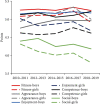Differences and Associations between Physical Activity Motives and Types of Physical Activity among Adolescent Boys and Girls
- PMID: 35686232
- PMCID: PMC9173893
- DOI: 10.1155/2022/6305204
Differences and Associations between Physical Activity Motives and Types of Physical Activity among Adolescent Boys and Girls
Abstract
Interventions aimed at motivation for physical activity (PA) are mostly beneficial, but the effects on preventing the decrease in PA are not entirely clear, especially in girls. The main aim of this study was to identify the differences and associations between PA motives and types of PA in boys and girls and between low and high motivated boys and girls. Another aim is to identify the types of motivation and PA that increase the likelihood of achieving PA recommendations and to propose ways of increasing PA among low motivated adolescents. The research carried out before the COVID-19 pandemic (2010-2019) and involved 2,149 Czech and 1,927 Polish adolescents aged 15-19 years. The International Physical Activity Questionnaire-Long Form was used to identify the level of PA types, while PA motivation was examined through the Motives for Physical Activities Measure-Revised. During the ten years, a decline was observed in enjoyment, fitness, and social motives. An increase in appearance motives was observed in girls, while no significant changes were seen in boys. Boys showed a higher motivation for PA than girls in enjoyment, competence, fitness, and social motives, while girls were high motivated in appearance motives. The greatest statistically significant differences between low and high motivated individuals were found in the associations between recreation/vigorous PA and between all types of motivation in boys and girls in both countries. The strongest associations in both genders were observed between enjoyment/competence motives and recreation/vigorous PA. Respecting and using the associations between the types of PA motives and types of PA in low and high motivated boys and girls can support feelings of PA enjoyment, increase PA, support the achievement of PA recommendations, and positively affect adolescents' healthy lifestyles.
Copyright © 2022 Karel Frömel et al.
Conflict of interest statement
No potential conflict of interest was reported by the authors.
Figures




Similar articles
-
Understanding the Motives of Undertaking Physical Activity with Different Levels of Intensity among Adolescents: Results of the INDARES Study.Biomed Res Int. 2018 Sep 30;2018:1849715. doi: 10.1155/2018/1849715. eCollection 2018. Biomed Res Int. 2018. PMID: 30364033 Free PMC article.
-
Associations between physical activity motives and trends in moderate-to-Vigorous physical activity among adolescents over five years.J Sports Sci. 2021 Oct;39(19):2147-2160. doi: 10.1080/02640414.2021.1923203. Epub 2021 Jul 14. J Sports Sci. 2021. PMID: 34259129
-
Do Motives to Undertake Physical Activity Relate to Physical Activity in Adolescent Boys and Girls?Int J Environ Res Public Health. 2015 Jul 8;12(7):7656-66. doi: 10.3390/ijerph120707656. Int J Environ Res Public Health. 2015. PMID: 26184246 Free PMC article.
-
Physical activity motives, barriers, and preferences in people with obesity: A systematic review.PLoS One. 2021 Jun 23;16(6):e0253114. doi: 10.1371/journal.pone.0253114. eCollection 2021. PLoS One. 2021. PMID: 34161372 Free PMC article.
-
A sex/gender perspective on interventions to promote children's and adolescents' overall physical activity: results from genEffects systematic review.BMC Pediatr. 2020 Oct 10;20(1):473. doi: 10.1186/s12887-020-02370-9. BMC Pediatr. 2020. PMID: 33038924 Free PMC article.
Cited by
-
Adolescent physical activity during school days: a comparative study before and after COVID-19 pandemic restrictions.Front Public Health. 2025 Mar 14;13:1488153. doi: 10.3389/fpubh.2025.1488153. eCollection 2025. Front Public Health. 2025. PMID: 40161017 Free PMC article.
-
Should organized sport characteristics be considered as a strategy for meeting physical activity guidelines in children?Glob Health Promot. 2024 Dec;31(4):75-84. doi: 10.1177/17579759241237525. Epub 2024 Mar 27. Glob Health Promot. 2024. PMID: 38539277 Free PMC article.
-
Physical activity in professional training of physiotherapists.Ann Med. 2025 Dec;57(1):2446687. doi: 10.1080/07853890.2024.2446687. Epub 2025 Jan 2. Ann Med. 2025. PMID: 39744898 Free PMC article.
-
Associations between preference and participation in team sports: Physical activity promotion among adolescents.Front Public Health. 2022 Nov 29;10:1024932. doi: 10.3389/fpubh.2022.1024932. eCollection 2022. Front Public Health. 2022. PMID: 36523587 Free PMC article.
-
The Effect of Motivation on Physical Activity among Middle and High School Students.Sports (Basel). 2024 May 30;12(6):154. doi: 10.3390/sports12060154. Sports (Basel). 2024. PMID: 38921848 Free PMC article.
References
-
- Moreno-Murcia J. A., Hellín P., González-Cutre D., Martínez-Galindo C. Influence of perceived sport competence and body attractiveness on physical activity and other healthy lifestyle habits in adolescents. The Spanish Journal of Psychology . 2011;14(1):282–292. doi: 10.5209/rev_sjop.2011.v14.n1.25. - DOI - PubMed
-
- van de Kop J. H., van Kernebeek W. G., Otten R. H. J., Toussaint H. M., Verhoeff A. P. School-based physical activity interventions in prevocational adolescents: a systematic review and meta-analyses. Journal of Adolescent Health . 2019;65(2):185–194. doi: 10.1016/j.jadohealth.2019.02.022. - DOI - PubMed
MeSH terms
LinkOut - more resources
Full Text Sources
Medical

